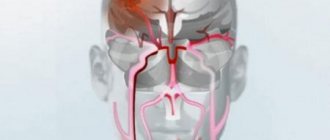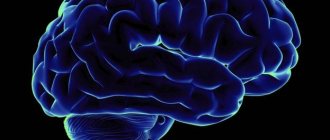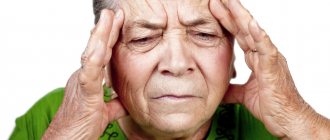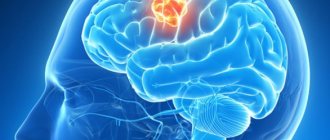Arterial hypertension is a risk factor for stroke. In most patients, blood pressure levels are elevated during the acute stage of stroke, which reflects a compensatory reaction that develops when there is insufficient blood supply to the brain. Restoring normal blood pressure values in the acute stage of stroke is indicated for patients with an aggravated form that occurs against the background of heart failure, kidney pathologies and other diseases. Statistics show that an episode of stroke can occur in patients of any age and does not directly depend on current blood pressure levels.
Characteristic
During a stroke, the pressure usually increases, then decreases if correct antihypertensive therapy is carried out or the patient’s condition is stabilized and blood pressure levels are spontaneously regulated. According to statistics, the average readings within 48 hours after the onset of stroke in 75-82% of patients are more than 140 mmHg. Art. (systolic blood pressure is the pressure created as a result of contraction of the heart muscle).
In 25-28% of patients, systolic (upper) pressure during stroke exceeds 180 mmHg. Art. An increase in blood pressure during stroke is a compensatory reaction of the body aimed at stimulating blood supply to the ischemic area. The mechanism of the compensatory reaction involves the pathways of collateral blood flow or promotes the movement of occluding (clogging the vascular lumen) elements into the distal segments of the arterial bed.
During the period of stroke, cerebrovascular reactivity is disrupted - the volume and speed of blood flow in the circulatory system that supplies the brain. Cerebrovascular reactivity depends on the indicators of systemic (reflects the parameters of the force acting on the arterial walls as a result of the contractile activity of the heart) blood pressure. High blood pressure levels, which occur during the acute period of stroke, are associated with the risk of developing a recurrent episode of stroke, which significantly worsens the prognosis.
According to statistics, if within 48 hours after the manifestation of a stroke, systolic (upper) blood pressure is above 150 mm Hg. Art., every 10 mm Hg. Art. increases are associated with a 4.2% increase in the risk of recurrent stroke (over the next 2 weeks). An increase in pressure values correlates with the transformation of an ischemic type of infarction into a hemorrhagic form and the occurrence of complications - cerebral (edema of the brain) and extracerebral (myocardial infarction).
If blood pressure drops during a stroke, the prognosis also worsens. Some studies provide data on an increase in the percentage of mortality with significantly reduced pressure during an episode of stroke. Low blood pressure and high pulse when cerebral blood flow is disrupted in an acute form occurs infrequently and is usually a consequence of sepsis (blood poisoning), myocardial infarction covering a wide area, ischemic processes in the myocardium, and heart failure.
A stroke can occur with normal pressure if the pathogenesis is dominated by other provoking factors - diabetes mellitus, thrombosis of cerebral arteries, cerebral embolism, atherosclerotic damage to the vascular walls. In a hemorrhagic stroke, insufficient blood supply to a part of the brain is caused by bursting vessels, from which blood flows into the brain tissue.
According to statistics, strokes are rarely diagnosed in children and relatively healthy people who do not suffer from chronic diseases and do not complain of hypertension. The causes of occurrence in these cases are often associated with congenital anomalies in the development of the circulatory system that feeds the brain and heart disease. These include atrial fibrillation and arteriovenous malformations, which are characterized by a unique structure - a direct connection of arteries and veins without the formation of a capillary network.
Blood pressure within the arteriovenous malformation is increased, which leads to aggressive mechanical effects on the tissue of the vascular wall. Under unfavorable factors (spasm, dystonia - changes in the tone of the vascular wall), under the influence of high pressure, the integrity of the vascular endothelium is damaged, which leads to the appearance of a focus of hemorrhage. With atrial fibrillation, cases of ischemic strokes are common, which is due to low cardiac output.
Pathogenesis and manifestations of the disease
A stroke is a disruption of blood circulation in a specific area of the brain. Due to changes in blood flow, organ malfunction occurs. There are several types of apoplexy:
- Hemorrhagic stroke is a rupture of a large vessel with effusion into one of the membranes of the brain. It is more common than other species. Blood fills the part of the brain in which the rupture occurred, a blood clot forms at the site, and swelling occurs. Enlargement of the department and meninges leads to compression of nearby departments, and the functioning of the brain is disrupted.
- Ischemic stroke is a cessation of blood supply to the brain and meninges as a result of blockage of the bloodstream by a thrombus. The brain does not receive the necessary nutrients and oxygen, and necrosis of the area occurs.
- A microstroke is a short-term disruption of the blood circulation in the brain that does not have serious consequences.
- Spinal stroke is a pathological change in blood flow in the spinal cord.
The cause of the pathology is vascular disorders. Blood supplies nutrition and oxygen, without which full functioning is impossible. The brain reacts more acutely than other organs of the human body to cessation of nutrition. The absence of oxygen for 3-4 minutes leads to hypoxia.
The cause of hemorrhagic stroke is increased blood pressure. An increase in the volume of circulating blood causes increased pressure on the vessel - it ruptures. Blood pours into the meninges, forming a thick clot that affects the functioning of the organ. The patient’s condition and the manifestations of the disease depend on the degree of damage and the size of the ruptured vessel. Often leads to death.
See also: Does yoga help with high blood pressure?
Ischemic stroke occurs due to a lack of blood flow to the brain. The cause is thromboembolism due to a ruptured vessel as a result of high blood pressure. The patient's condition is serious, dangerous due to the appearance of a dead part of the brain, and coma ensues.
Causes of stroke:
- hypertonic disease;
- vascular atherosclerosis;
- cardiac ischemia;
- cardiac arrhythmia;
- diabetes.
All vascular pathologies are possible prerequisites for stroke. Patients with such diagnoses are at risk.
Symptomatic manifestations depend on the severity of the lesion. With excessive hemorrhage, the patient loses consciousness, breathing is impaired, and convulsions are possible. The pupils are constricted, there is no pain sensitivity, spontaneous urination and defecation.
The first signs of cerebrovascular accident:
- confusion;
- incoherent speech;
- gait disturbance;
- numbness of one side of the face, torso, upper or lower limb;
- headache, dizziness.
Blood pressure may decrease or remain elevated after a stroke. Rapid breathing, shortness of breath, tachycardia.
Vascular atherosclerosis
Hypertensive stroke
The condition of insufficient blood supply to the brain, which is provoked by a hypertensive crisis, is called a hypertensive stroke. Features of stroke of the hypertensive type are a sharp, significant increase in blood pressure and mild neurological deficit. According to the nature of the course and clinical picture, an episode of stroke resembles a hypertensive crisis. Symptoms accompanying an episode of stroke when blood pressure has increased significantly:
- Pain in the head area. The pain is predominantly dull in nature, localized in the occipital and frontal region, aggravated by coughing and head movements.
- Nausea accompanied by bouts of vomiting.
- Dizziness, inability to maintain balance.
- Impaired motor coordination.
- Paresis (muscle weakness) of the limbs.
- Paresthesia (sensitivity disorder).
- Speech dysfunction.
The diagnosis of stroke is made on the basis of progressive neurological symptoms that occur against the background of increasing blood pressure values. During a hypertensive crisis, the patient's condition improves, signs of neurological disorders regress without a trace, when blood pressure levels decrease and return to normal.
The role of arterial hypertension in the development of stroke
A stroke can occur at any pressure, because it develops as a result of insufficient blood supply to brain tissue, which more often reflects a violation of the patency of elements of the circulatory system. Arterial hypertension provokes the development of stroke through the involvement of mechanisms in the pathogenesis - oxidative stress, endothelial dysfunction, loss of elasticity of vascular walls.
Other provoking factors: increased permeability of the arterial wall, spasm of the muscles lining the vascular wall, remodeling (changes in the structural and geometric structure) of resistive (small-caliber arteries and arterioles that resist blood flow) arteries. Stroke often occurs at low pressure, which may be due to occlusion of the cerebral arteries and is manifested by insufficient blood supply to the brain tissue with the subsequent development of ischemic-necrotic processes.
If a stroke occurs, in the vast majority of cases (80% of patients), pressure levels immediately increase in the ischemic and hemorrhagic form, which develops due to the fact that blood vessels burst and hemorrhage occurs in the brain matter. Stroke rarely occurs with low or normal blood pressure (less than 20% of cases). Symptoms of stroke with low blood pressure are the same as with high blood pressure:
- Inability to raise an arm or leg in an upward direction.
- Lack of facial expressions in one half of the face (drooping of the corner of the lips, upper eyelid and corner of the eye, the patient cannot smile, the nasolabial fold disappears).
- Visual impairment on one side.
- Dysarthria (disorder of formed speech).
The patient cannot pronounce words and does not respond to phrases addressed to him. The development of stroke with arterial hypotension occurs due to the lack of normal tone of the muscles of the vascular wall. Arterial walls lose elasticity, become flabby and inert. Even small blood clots or emboli can clog the vascular lumen.
Pressure control in the acute period of stroke
There is no clear opinion regarding the nature of therapy aimed at reducing blood pressure in the acute stage. In 57% of cases, antihypertensive therapy is carried out upon admission to a medical facility. In 54% of cases, medications are used that the patient took before the stroke episode occurred; in 45%, doctors prescribe other antihypertensive medications.
If during a stroke in women and men, systolic pressure levels decrease by more than 20 mm Hg. Art. daily, this can be dangerous because it negatively affects the neurological status, which reflects the degree of damage to brain structures; the doctor must take into account the likelihood of an increase in the area of the infarction. The expansion of the diameter of the infarction is associated with damage to the vascular wall. Through the bursting of small vessels, blood seeps into the brain matter.
Multiple small foci of hemorrhage cause swelling of the brain tissue. When large foci of hemorrhage form, complications often arise - dislocation and compression of the brain matter, which often causes death. With a sharp decrease in blood pressure during the acute period of stroke, a repeated episode can occur within 3 months from the moment the stroke occurred. Clinical recommendations in the acute stage of stroke suggest the following tactics:
- Prescription of antihypertensive drugs in the case of blood pressure values in the ischemic form above 200-220 mm Hg. Art. (systolic) or 120 mm Hg. Art. (diastolic). In the hemorrhagic form, indications for therapy are values above 180 mmHg. Art. (systolic) and 105 mm Hg. Art. (diastolic).
- Lack of routine antihypertensive treatment at lower blood pressure levels.
- Antihypertensive therapy of an emergency nature is carried out in patients with confirmed heart failure or myocardial infarction. Other indications: acute renal failure, aortic dissection (rupture of the intima and medial layer of the aortic wall), thrombolysis (thrombolytic therapy, destruction of blood clots due to the use of pharmaceuticals). During thrombolysis, systolic blood pressure is maintained below 180 mmHg. Art.
Recommended target values for systolic blood pressure are 100-180 mmHg. Art. (history of arterial hypertension), 160-180 mm Hg. Art. (no history of hypertension). The drug of first choice for correcting blood pressure values in the acute stage of stroke is Ebrantil (Urapidil). The drug acts as an alpha-blocker, gently, controllably reduces blood pressure.
The medicine is effective and has few side effects. A stroke without pressure is as dangerous as an episode of stroke against the background of a significantly increased blood pressure. In cases where there is low blood pressure after the onset of an ischemic stroke, the values need to be adjusted, which will improve the prognosis.
If the pressure after an ischemic stroke in the acute stage of its course decreases significantly, a search for causes is carried out. Among the possible causes, it is worth noting myocardial infarction, aortic dissection (dissecting aneurysm - rupture of the walls with blood leaking between the layers), thromboembolism of the pulmonary artery.
The pulse during a stroke against the background of myocardial infarction can drop to 50 beats/min. or increase to 90 beats/min., depending on the nature of the pathology. If it is not possible to establish the exact cause, infusion therapy with low molecular weight dextrans and crystalloid (saline) solutions - blood substitutes (Sodium chloride solution) is carried out.
At what pressure can a stroke occur?
It is impossible to identify prematurely at what blood pressure level a stroke can occur, since each person’s body has individual characteristics. The risk of pathology in 65% of cases is influenced not by a stable pressure indicator, but by its sharp jump. A person with normal blood pressure may have a stroke due to the sudden development of a hypertensive crisis.
A strong surge in circulating blood volume can cause cerebral artery rupture. In such a situation, emergency measures are required, as the likelihood of developing a manifest stroke increases. If a vessel in the brain ruptures with high blood pressure and a rapid heart rate, acute hemorrhage may occur. A hemorrhagic stroke can lead to swelling of the brain.
Low blood pressure does not exclude the possibility of developing a cerebrovascular accident. In the case of slow blood pressure, low circulating blood volume and bradycardia, the trophism of brain tissue is disrupted. Neurons stop receiving the required amount of energy. Cells begin to die due to oxygen deficiency.
Important information: What is the danger of pneumonia after a stroke in bedridden patients and survival prognosis
Stroke attacks occur even in healthy people when there is a sudden increase in blood pressure in a stressful situation. Blood pressure rises more often during a stroke in men than in women.
For hypertension
People with high blood pressure are 4-6 times more likely to have a stroke, and the risk of developing severe complications increases, especially if they have chronic hypertension and an unhealthy lifestyle. Progressive pathology is the cause of atherosclerotic changes in the vascular endothelium. When cholesterol plaques appear, obstruction of the main arteries occurs. As a result, afterload on the heart increases and pressure on blood vessels throughout the body increases. The vascular wall of small-diameter arteries becomes thinner and weakens, and the blood thickens.
In this situation, the risk of blood clots and subsequent rupture in the vessels that deliver oxygen and nutrients to the neurons of the brain increases. Consistently high blood pressure numbers in the case of chronic hypertension can cause acute cerebral circulatory failure. After ischemia, a stroke occurs. To prevent further progression of the pathology, treatment is required on an ongoing basis, regardless of the presence or absence of a symptomatic picture.
Only the attending physician can correctly select drugs for drug therapy to stabilize blood pressure. The specialist examines the patient and assesses the condition based on the examinations performed. The cardiologist will explain what pressure occurs during a stroke and write out appropriate recommendations to prevent pathology. If you follow all the instructions for antihypertensive treatment, then in most cases ischemia does not occur.
A rupture of a vessel in the brain occurs due to diseases of the arteries that supply the retina. Therefore, to eliminate the risk of stroke, fundus examination and microangiopathy are performed.
For hypotension
When asked whether a stroke can occur with low blood pressure, cardiologists answer in the affirmative. At the same time, an increase in blood pressure against the background of low blood pressure causes more complications than with chronic hypertension. Arterial hypotension increases the risk of death.
A stroke with low blood pressure is not caused by thrombus formation; the pathological process occurs due to insufficient blood flow to the neurons of the brain. Cells begin to die due to hypoxia and nutrient deficiency. Therefore, if your blood pressure increases, you should not immediately take strong antihypertensive drugs.
Low blood pressure after a stroke can trigger a relapse. When blood pressure decreases in a person who has suffered a cerebral vessel rupture, the blood supply to the affected area deteriorates. In such a situation, it is impossible to carry out stem cell therapy, renew neurons and restore lost functions. The re-development of necrosis of brain cells against the background of hypotension is indicated by a disorder of facial expressions.
Important information: What medications are prescribed to take to treat a microstroke of the brain?
Impairment of facial muscles, loss of cognitive function, or the occurrence of paresthesia are not associated with damage to the cranial nerves. With coronary artery disease, neurons in the brain begin to die, which reduces the functional activity of the peripheral and autonomic nervous systems. The latter is responsible for the normal functioning of organs. When it is damaged, the stroke is complicated by impaired peristalsis of smooth muscles.
At normal pressure
Many people wonder whether a stroke can occur with normal blood pressure. Acute cerebral circulatory disorders can develop regardless of factors such as blood pressure. In addition to blood pressure, the condition of the cerebral arteries is affected by:
- vascular health in the cervical spine;
- release of hormones;
- psycho-emotional stress;
- work of the central nervous system;
- functional activity of the adrenal cortex.
If blood pressure readings are normally 110/70 mmHg. Art., but under the influence of stress factors they rise above 150-160 mm Hg. Art. - this is a sign of a hypertensive crisis, as a result of which ischemia may occur.
The pressure during a stroke between the periods of systole and diastole should be more than 40 units. Otherwise, apoplexy develops.
What to do
If a stroke occurs, correctly provided first aid increases the likelihood of a favorable outcome. If characteristic symptoms appear, you must immediately call an ambulance. Before medical staff arrive, it is important to monitor blood pressure readings.
With a high value exceeding 180 mm Hg during systole. Art., antihypertensive drugs should not be given. At this level of blood pressure, healthy cells near the lesion will be fully supplied with oxygen and nutrients. In case of timely treatment, they will help restore lost functions.
An increase in pressure is a compensatory reaction of the body, aimed at protecting the functional activity of the brain. If blood pressure parameters remain at the same level for 12 hours, the risk of complications is reduced and the chance of full rehabilitation increases.
In some cases, systolic blood pressure readings drop below 160 mmHg. Art. This means the beginning of irreversible tissue necrosis. The body is not able to restore cells damaged by necrosis, and the likelihood of death is high.
To prevent a drop in blood pressure, it is necessary to provide first aid within the first 4-5 hours after the stroke develops. Before the doctors arrive, you must complete the following steps.
| If the person is conscious | Fainted |
| Place the victim in a horizontal position. | Place the patient on a flat surface and raise the head above the floor with a pillow at 30° |
| Raise your head using available means 30° from the floor. This is necessary for the outflow of blood from the cranial cavity and to prevent swelling of the brain tissue. | Measure heart rate, blood pressure. Doctors are required to report low or sudden changes in blood pressure. |
| Measure heart rate and blood pressure values to provide doctors with the necessary information. | If the victim has difficulty breathing, it is necessary to throw back his head, open his mouth and move his lower jaw forward. If you cannot perform these actions, you should turn your head to the side. In this position, the patient will not be able to accidentally swallow his tongue. |
| It is forbidden to give food or liquid to the patient. | If necessary, it is necessary to clear the victim’s mouth of vomit. |
Important information: What are the contraindications to thrombolytic therapy (thrombolysis) for ischemic stroke









